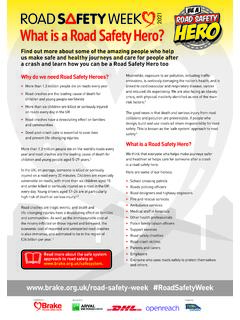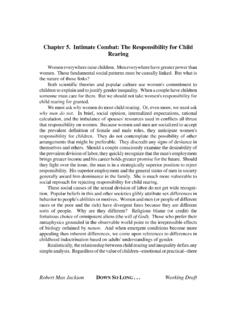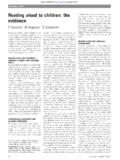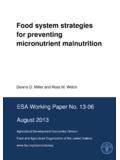Transcription of Teaching road safety - Brake
1 Brakethe road safety charityguide for educatorsof 2-18 year-oldsTeaching road safety : road safety is a great subject in which to engagechildren and young people. It's a subject even the youngest children know somethingabout because everyone uses roads, and road danger impacts on everyone. It s also a vitally important crashes are a major cause of death and injuryamong the young, with the risk rising as children reachsecondary school age and have more independence, andyoung drivers and passengers facing significant from traffic is also a big factor in whether childrenand young people are able to walk and cycle to school, tothe park or to see friends, and therefore their ability to behealthy and socially are some guidelines on what to teach different agegroups from age 2 to 18, and some ideas for lessons andactivities, including some that can be run in assemblies orcitizenship lessons.
2 And some that can be incorporatedinto subjects like Maths, Science, Drama and can also use our educational resources page to download posters, videos and other resources you can use to help make road safety an interesting and engaging road safety : guide for educatorsSign up for Brake s termly educators e-bulletinfor updates about Teaching road safety . Find out about other ways schools can promote road to teach: age-appropriate messages4 Early years: age 2-5 Teaching ideas6 Key Stage 1: age 5-7 Teaching ideas7 Key Stage 2: age 7-11 Teaching ideas8 Key Stage 3: age 11-14 Teaching ideas10 Key Stage 4 and beyond: age 14-18 Teaching ideas11 children with special educational needs (SEN) 13 road safety policies and safe school trips13 Practical pedestrian and cycling training14 Campaigning for safer streets in your community14 Brake events for educators141 This guide to Teaching road safetywas created by Brake ,the road safety charity with supportfrom the Departmentfor Transport.
3 Before you start2 This guide is also available online at road safety : guide for educatorsSensitivity issuesBefore Teaching road safety , check if any children have been bereaved by, hurt in, or witnessed a serious road crash, and besensitive to their needs. Talk to them and their carers aboutwhether they wish to be excluded from lessons or activities thatdiscuss death or injury. (If your school or any students experiencea bereavement in a road crash, you can see Brake 's reports onchild bereavement and order our child bereavement support literatureto help you support them.)Getting outside helpBear in mind that classroom Teaching is more effective if combinedwith practical experiences and campaigning.
4 So if you can build inthese three components it will have greater impact: classroom Teaching roadside experiences and training (which must be delivered safely) getting the children campaigning for road can get advice on all three of these elements in this guide, butto successfully deliver on them, especially practical training, youmay need or benefit from outside help. For example, road safetyofficers from local authorities can visit schools to run practicalpedestrian and cycling training for children . You may also be ableto work with emergency services to help you teach road safety inan exciting way, and convey why road safety is important, such asby giving talks in assemblies, or helping to supervise and deliverpractical experience-based lessons or might also be able to get help from a local company who couldprovide funding to aid your road safety work, or volunteers to helpsupervise, or help you promote a campaign led by the children (for example by providing space to display banners and posters).
5 You can also make use of Brake s road safety events and programmesto help you bring road safety to life, and link yourteaching with a national programme. Many of these include freeresource packs and guidelines to help you get involved. In particular, road safety Weekis the UK s biggest road safetyevent, organised by Brake every November, and a time when thousands of educators, local authorities, emergency services andemployers work to promote road safety . Register for a free e-action everyone on boardYou may need to persuade others within your school, nursery or college, such as other teachers, the head or board, about theimportance of road safety before you start Teaching and promotingit.
6 Here are a few key points you can make to help persuade others: Every death or serious injury of a child on roads is devastating for the family, the wider community, and the pre-school, school or college and every one is preventable. No child should lose their life or suffer a horrendous injury on roads. Poor road safety not only means children are in danger of being hurt or killed, it also often affects their health and wellbeing. children are increasingly being driven to school, and are less likely to regularly walk and cycle, contributing to inactivity, obesity and affecting social development.
7 If streets are unsafe, parents are less willing to let their children walk or cycle. Educators can play a vital role in protecting children and stopping devastating casualties by Teaching life-saving messages to pupils, and promoting road safety more widely such as to parents and drivers in the area. Schools and colleges can lead the way in making local roads safer, especially enabling children and families to walk and cycle safely. You are at the heart of a community and therefore well placed to work with authorities to help achieve improvements to local roads to make them safer for children and adults, such as through paths, crossings, lower speed limits and better law enforcement.
8 (Read our guide on campaigning.) road safety can help you meet Teaching requirements and demonstrate to people in the area that you are a school that cares about pupils safety and wellbeing. road safety is not just a subject for younger children . The older children get, the more at risk they become, as they gain independence. This includes when they are on foot or bicycle, and when they may start to drive or be passengers with other young drivers. Crashes involving young drivers are a big problem, causing one in five serious road casualties, so improving awareness of the risks on roads is crucial for teenagers too.
9 Before you startGetting parents on boardGetting parents on board with your road safety messages is vitallyimportant, given their responsibilities for protecting children , especially at a younger age, and as children are likely to copy theirparents behaviour, including any bad habits. It s therefore a goodidea when planning road safety Teaching to consider how you canreach out to parents at the same time. Encouraging parents to behave safely on roads, as drivers, pedestrians and cyclists, and to display positive attitudes towardsroad safety , will help make sure what you are Teaching in the classroom is being positively reinforced at home.
10 Engaging parentswith road safety messages can also of course make roads aroundthe school safer by encouraging them to slow down and parksafely, or to leave the car at home and walk or cycle to school ifthere are safe of the activity and Teaching ideas below incorporate ways toengage parents, but whatever you re planning you could: Include something in your newsletter, website or on social media, and/or send out letters, informing them of what you will be Teaching the children and suggesting ways they can reinforce the messages at home and lead by example; Encourage parents to sign the Brake Pledge, a six point pledge covering key road safety topics; Direct parents to , Brake s road safety advice for families, and directly communicate the key messages; Display posters in your reception area promoting road safety activities you re running and road safety messages.








